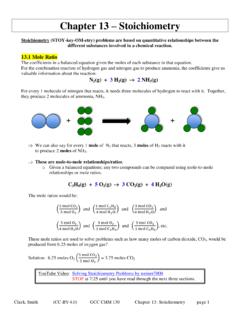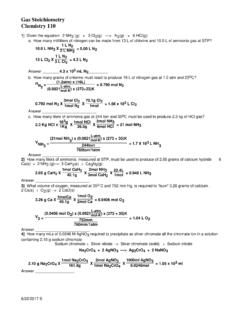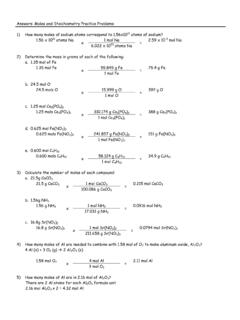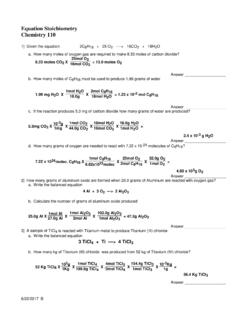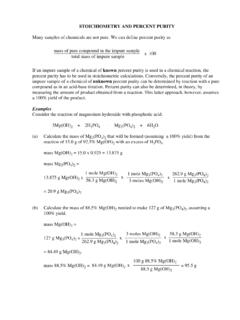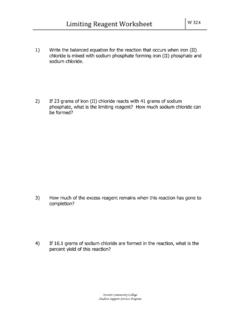Transcription of Stoichiometry - Montgomery College
1 Reaction Stoichiometry Grams of Grams of Substance A Substance B. Molar mass of A Molar mass of B. Use coefficients Moles of Moles of of A and B from Substance A Substance B. balanced equation The coefficients in a balanced chemical equation specify the relative amounts in moles of each of the substances involved in the reaction. 2 C8H18 (l) + 25 O2(g) 16 CO2 (g) + 18 H2O(g). 2 mol C8H18 : 25 mol O2 : 16 mol CO2 : 18 mol H2O. How many grams of glucose can be synthesized from g of CO2 in photosynthesis? Given 6 CO2 + 6 H2O C6H12O6+ 6 O2 g CO2. Find g C6H12O6. Conceptual Plan: Relationships: 1 mol C H O = , 1 mol CO = , 1 mol C H O : 6 mol CO. 6 12 6 2 6 12 6 2. Solution: How many grams of O2 can be made from the decomposition of g of PbO2?
2 Given 2 PbO2 2 PbO + O2 g PbO2. Find g O2. Conceptual Plan: Relationships: 1 mol O2 = , 1 mol PbO2 = , 1 mol O2 : 2 mol PbO2. Solution: Practice Problems 1. How many grams of water produced in the oxidation of g of glucose, C6H12O6? C6H12O6 (s) + 6 O2 (g) 6 CO2 (g) + 6 H2O (l). No direct g C6H12O6 (c) g H2O. calculation 1 C6H12O6 g H2O. C6H12O6 1 mol H2O. 6 mol H2O. (a) mole C6H12O6 (b) mole H2O. 1 mol C6H12O6. 2. Automotive air bags inflate when sodium azide, NaN3, rapidly decomposes to its component elements;. 2 NaN3 (s) 2 Na (s) + 3 N2 (g). (a) How many moles of N2 are produced by the decomposition of mol of NaN3? (b) How many grams of NaN3 are required to form g of nitrogen gas?
3 References: Tro, Chemistry: A Molecular Approach 2nd ed., Pearson Brown/LeMay/Bursten, Chemistry: The Central Science, 12th ed., Pearson 2. (a) mol N2; (b) g NaN3. 1. (a) x 10-3 mol C6H12O6; (b) x 10-3 mol H2O; (c) g H2O. Answers





